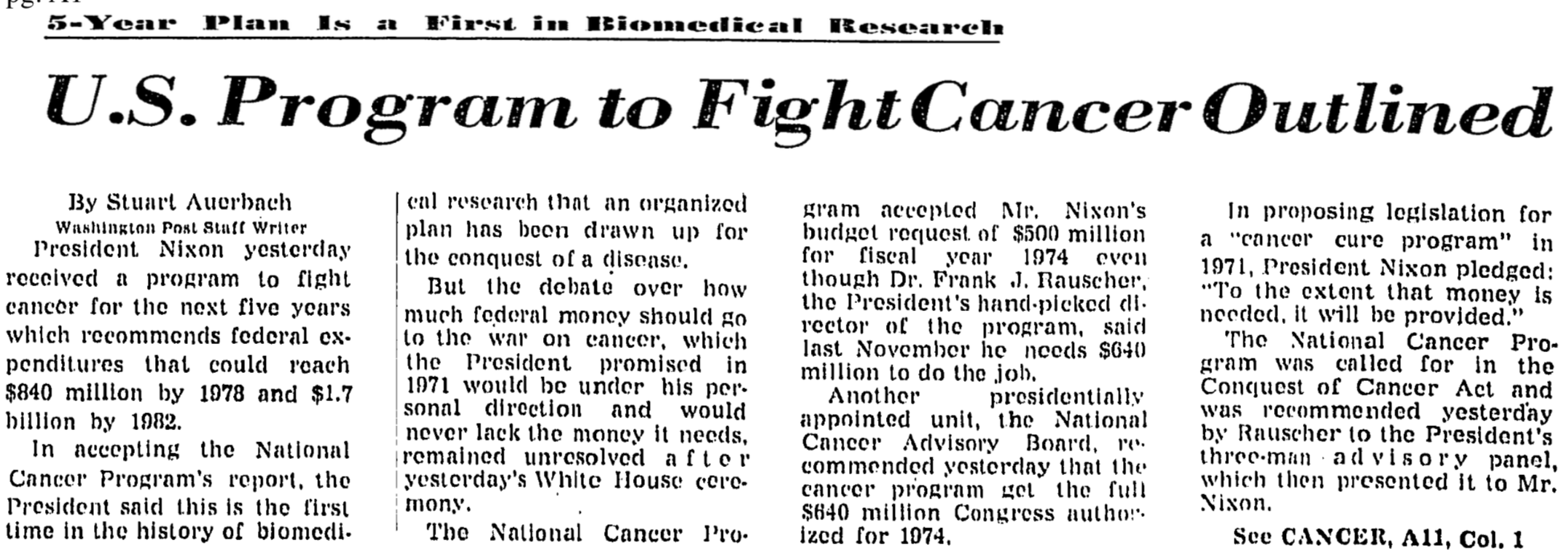President Nixon and the
War on Cancer
In January 2010, Dr. James Cavanaugh, one of RN’s principal advisers on health policy, spoke about the President’s early efforts at health care reform at the Nixon Library. His presentation was part of a panel of key White House officials who helped spearhead the President’s domestic policy initiatives.
“I think for people who follow health issues, who follow health policy, who follow the history of healthcare programs in this country,” RN’s legacy “will be fairly good.” Cavanaugh said. “People who realistically look at what his program had look at it favorably.”
One of those people was Dr. Alva Hamblin Letton.
As President of the American Cancer Society, he was present at the White House on December 23, 1971 when RN signed the National Cancer Act.
Dr. Letton called the legislation “the greatest thing ever done by the United States,” and expressed his deepest appreciation that President Nixon made the fight against cancer a national priority.
According to the estimates of the American Cancer Society, the decade of the 1970s would see 3.5 million deaths from cancer, 6.5 million new cancer cases diagnosed, and more than 10 million cancer patients under medical care. Cancer accounted for roughly one-sixth of all deaths in the United States each year, second only to cardiovascular diseases. But though second in mortality, cancer was consistently cited by the public as the most feared disease. This prompted the formulation of the National Cancer Act.
Elmer Bobst, who was an advisor on health issues for RN and Benno Schmidt, Chairman of the special Panel of Consultants for the Conquest of Cancer, started assembling a host of recommendations for legislation by House leadership and other prominent Republican lawmakers.
Schmidt stressed that the controversial recommendation for a separate agency was necessary if cancer were to be declared a national goal, and expressed the hope that the President would find the panel’s recommendation worthy of support.
George Shultz, the Director of the Office of Management and Budget, and Ehrlichman were in a position to get this to the President’s attention. President Nixon seized the initiative and recommended an additional $100 million to the budget for cancer research and announced this step in his State of the Union message.
“ I will ask for an appropriation of an extra $100 million to launch an intensive campaign to find a cure for cancer, and I will ask later for whatever additional funds can effectively be used. The time has come in America when the same kind of concentrated effort that split the atom and took man to the moon should be turned toward conquering this dread disease. Let us make a total national commitment to achieve this goal.”
Exactly one week later, President Nixon sent The Budget of the United States Government for Fiscal 1972 to the Congress. It included a request for $232 million for the National Cancer Institute and a special request of $100 million for “cancer research initiatives” that would use “all pertinent institutes and agencies” of the federal government.
Two months before the December 23rd signing, RN announced the conversion of a biological research facility “into a leading center for cancer research.”
Almost forty-years on, RN’s cancer initiative continues to revolutionize the field of biomedical research. Today, there are 61 designated cancer centers, 300 different antidotes for the disease including cures for childhood cancers, effective treatments for kidney and colo-rectal cancers, and adjuvant therapies for solid tumors. This progress against the world’s deadliest disease is not only a crowning achievement for RN’s Presidency, but also for the millions of cancer survivors today.

